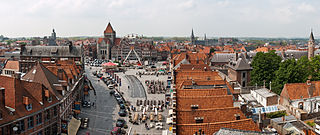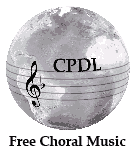
John Taverner was an English composer and organist, regarded as one of the most important English composers of his era.
Antoine Brumel was a French composer. He was one of the first renowned French members of the Franco-Flemish school of the Renaissance, and, after Josquin des Prez, was one of the most influential composers of his generation.

Jacob Obrecht was a Flemish-Dutch, Low Countries composer. He was the most famous composer of masses in Europe in the late 15th century, being eclipsed by only Josquin des Prez after his death.

Antoine Busnois was a French composer and poet of the early Renaissance Burgundian School. While also noted as a composer of motets and other sacred music, he was one of the most renowned 15th-century composers of secular chansons. He was the leading figure of the late Burgundian school after the death of Guillaume Dufay.

Alexander Agricola was a Netherlandish composer of the Renaissance writing in the Franco-Flemish style. A prominent member of the Grande chapelle, the Habsburg musical establishment, he was a renowned composer in the years around 1500, and his music was widely distributed throughout Europe. He composed music in all of the important sacred and secular styles of the time.
Pierre de la Rue was a Franco-Flemish composer and singer of the Renaissance. His name also appears as Piersson or variants of Pierchon and his toponymic, when present, as various forms of de Platea, de Robore, or de Vico. A member of the same generation as Josquin des Prez, and a long associate of the Habsburg-Burgundian musical chapel, he ranks with Agricola, Brumel, Compère, Isaac, Obrecht, and Weerbeke as one of the most famous and influential composers in the Netherlands polyphonic style in the decades around 1500.
Jean Mouton was a French composer of the Renaissance. He was famous both for his motets, which are among the most refined of the time, and for being the teacher of Adrian Willaert, one of the founders of the Venetian School.
Arnold de Lantins was a Netherlandish composer of the late medieval and early Renaissance eras. He is one of a few composers who shows aspects of both medieval and Renaissance style, and was a contemporary of Dufay during Dufay's sojourn in Italy.
Johannes Regis was a Netherlandish composer of the Renaissance. He was a well-known composer at the close of the 15th century, was a principal contributor to the Chigi Codex, and was secretary to Guillaume Dufay.
Johannes Pullois was a Franco-Flemish composer of the Renaissance, active in both the Low Countries and Italy. He was one of the early generation of composers to carry the Franco-Flemish polyphonic style from its home region in the Netherlands to Italy.

The Missa de Beata Virgine is a musical setting of the Ordinary of the Mass, by Renaissance composer Josquin des Prez. A late work, probably composed or assembled around 1510, it was the most popular of his masses in the 16th century.
Guillaume Faugues was a French composer. Very little is known of his life, however, a significant representation of his work survives in the form of five mass settings. Faugues holds an important place in the history of the Parody mass because of his use of the technique, particularly in Missa Le serviteur.
The Missa Sine nomine is a setting of the Ordinary of the Mass by Renaissance composer Josquin des Prez. It is a work of his maturity, probably dating from the period after he returned to Condé-sur-l'Escaut in 1504. It is one of Josquin's only masses not to be based on pre-existing material, and like the Missa ad fugam, it is a canonic mass.
A Missa sine nomine, literally a "Mass without a name", is a musical setting of the Ordinary of the Mass, usually from the Renaissance, which uses no pre-existing musical source material, as was normally the case in mass composition. Not all masses based on freely composed material were so named, but many were, particularly from the late 15th century through the 16th century.
Marbrianus de Orto was a Dutch composer of the Renaissance. He was a contemporary, close associate, and possible friend of Josquin des Prez, and was one of the first composers to write a completely canonic setting of the Ordinary of the Mass.

The Missa prolationum is a musical setting of the Ordinary of the Mass by Johannes Ockeghem, dating from the second half of the 15th century. Based on freely written material probably composed by Ockeghem himself, and consisting entirely of mensuration canons, it has been called "perhaps the most extraordinary contrapuntal achievement of the fifteenth century", and was possibly the first multi-part work written with a unifying canonic principle for all its movements.
Noel Bauldeweyn (first name also Noe, Natalis; surname also Balbun, Balduin, Bauldewijn, Baulduin, Baulduvin, and Valdovin; was a Franco-Flemish composer of the Renaissance, active in the Low Countries. A contemporary of Josquin des Prez, he had a strong reputation until well after the middle of the 16th century. That some of his works have long been misattributed to Josquin, the most renowned composer of the age, is indicative of his skill as a composer.














